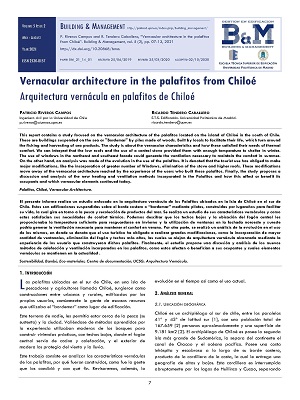
Vernacular architecture in the palafitos from Chiloé = Arquitectura vernácula en palafitos de Chiloé
DOI: https://doi.org/10.20868/bma.2021.2.4682
Texto completo:
PDFResumen
Abstract
This report contains a study focused on the vernacular architecture of the palafitos located on the island of Chiloé in the south of Chile. These are buildings suspended on the sea or "Bordemar" by piles made of woods. Built by locals to facilitate their life, which turn around the fishing and harvesting of sea products. The study is about the vernacular characteristics and how these satisfied their needs of thermal comfort. We can interpret that the low roofs and the use of a central stove provided them with enough temperature to shelter in winter. The use of windows in the northeast and southeast facade could generate the ventilation necessary to maintain the comfort in summer. On the other hand, an analysis was made of the evolution in the use of the palafitos. It is denoted that the tourist use has obliged to make major modifications, like the incorporation of greater number of Windows, elimination of the stove and higher roofs. These modifications move away of the vernacular architecture reached by the experience of the users who built these palafitos. Finally, the study proposes a discussion and analysis of the new heating and ventilation methods incorporated in the Palafitos and how this affect or benefit its occupants and which vernacular elements continued today.
Resumen
El presente informe realiza un estudio enfocado en la arquitectura vernácula de los Palafitos ubicados en la Isla de Chiloé en el sur de Chile. Estos son edificaciones suspendidas sobre el borde costero o “bordemar” mediante pilotes, construidas por lugareños para facilitar su vida, la cual gira en torno a la pesca y recolección de productos del mar. Se realiza un estudio de sus características vernáculas y como estas satisfacían sus necesidades de confort térmico. Podemos descifrar que los techos bajos y la ubicación del fogón central les proporcionaba la temperatura suficiente para resguardarse en invierno y la utilización de ventanas en la fachada noroeste y sureste podría generar la ventilación necesaria para mantener el confort en verano. Por otra parte, se realizó un análisis de la evolución en el uso de los mismos, en donde se denota que el uso turístico ha obligado a realizar grandes modificaciones, como la incorporación de mayor cantidad de ventanales, eliminación del fogón y techos más altos, las cuales se alejan de arquitectura vernácula alcanzada mediante la experiencia de los usuario que construyeron dichos palafitos. Finalmente, el estudio propone una discusión y análisis de los nuevos métodos de calefacción y ventilación incorporados en los palafitos, como estos afectan o benefician a sus ocupantes y cuales elementos vernáculos se mantienen en la actualidad .
Palabras clave
Referencias
Wikipedia, Archipiélago de Chiloé [Online]. Available: https://es.wikipedia.org/wiki/Archipi%C3%A9lago_de_Chilo%C3%A9#cite_note-c2012-1. fecha de último acceso: 15/04/2018
Instituto nacional de estadística INE [Online]. Available: https://www.ine.cl. fecha de último acceso: 15/04/2018
Múltiples autores, "Archipiélago de Chiloé guía de arquitectura", Gobierno de Chile
Múltiples autores, "Chiloé; ciudad entre mares", Asociación de municipalidades de Chiloé
Soto Delgado, Lisette , "Turistificación en los Barrios de Palafitos de Castro, Chiloé, Chile: Gamboa, Pedro Montt 1 y Pedro Montt 2.", Tesis para grado de Mas-ter, Universidad de Chile, 2017.
Palafito 1326 [Online]. Available: http://www.palafito1326.cl/es-es/entorno/architecture. fecha de último acceso: 22/05/2018
Meteoblue wheater [Online]. Available: https://www.meteoblue.com/es/tiempo/pronostico/modelclimate/ancud_chile_3899695.
Enlaces refback
- No hay ningún enlace refback.
Copyright (c) 2021 Autor / BY-NC-ND

Este obra está bajo una licencia de Creative Commons Reconocimiento-NoComercial-SinObraDerivada 4.0 Internacional.










